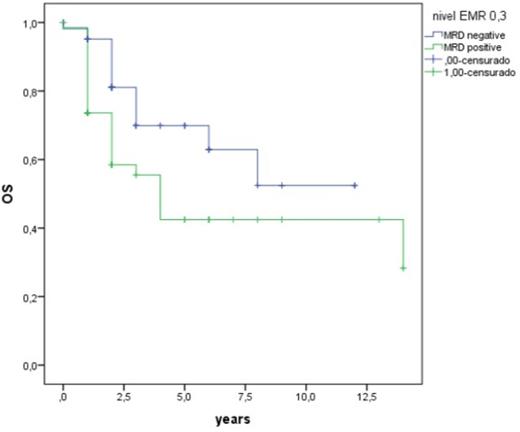Abstract
Background: The accumulated evidence from studies of multiparameter flow cytometric MRD (MFC-MRD) assessment in AML leaves little doubt that this method of MRD detection can be used to risk stratify both younger and older patients at treatment time points. Persistence of disease or high levels of pretransplantation minimal residual disease (MRD) have been reported to predict disease relapse after Allogeneic bone marrow transplantation (BMT). The prognostic impact of MFC-MRD is strong enough to have emerged despite study differences in the MFC assays and the limitations of now outdated restricted antibody panels.
Aims: To determine the value of Minimal Residual Disease (MRD) assessed by Multi-parameter Flow Cytometry (MFC) pretransplantation Allogeneic BMT, in predicting outcome in patients with acute myeloid leukemia (AML).
Methods: We performed a retrospective analysis the predictive value of MRD assessment by MFC pre trasnplantation alogeneic in 119 patients (diagnosed AML treated between january 2010 and october 2014 submitted at our institution who had available MRD assessment). MRD by MFC on bone marrow specimens obtained approximately 30 days before transplantation. MRD was identified as a cell population showing deviation from normal antigen expression patters compared with normal or regenerating marrow. The detection threshold for defining pre transplantation positive MRD was >0.3%.
Results - Of the 119 patients, 80 (67%) were in complete remission (CR1) , 31 (26%) CR2 and > CR2 8 (6%). Their median age was 38 years (Range, 10-64). Hyperleucocytosis in 39 (32%) and Cytogenetics was favorable risk in 32 (26%), intermediate risk in 39 (32.%), adverse risk in 35 (29%) and unknown in 13 (14%). There were a total of 44 deaths and 17 relapses; these contributed to the probability estimates for overall survival (OS) and disease free survival (DFS), stratified by MRD status and shown in figure 1. The median follow-up after BMT among survivors was 8.3 years (range, 6.9 to 9,6 years). The 7.5-years estimates of OS for MRD-positive and MRD-negative patients were 43.1% (range, 23,2% to 58,6%) and 68% (range 56% to 78.3%), respectively, and the 7,5 year estimates for DFS for MRD-positive and MRD-negative patients were 40.5% (range 21.4% to 52.6%) and 56% (range 42.5% to 65.8%).
After adjustment for various covariates, age, cytogenetics risk, hyperleucocytosis, secundary AML, the hazard ratios of MRD positive versus MRD negative were 2.06 (range 1.52 to 6.24; P=0,003) for overall mortality, 3.45 ( range 2.14 to 7.32; p=0.014) for DFS.
Conclusion:
That detection of MRD pre transplantation define a population of patients with AML who are at higher risk for adverse outcome, even after adjusting for other factors that influence post-BMT outcome.
No relevant conflicts of interest to declare.
Author notes
Asterisk with author names denotes non-ASH members.


This feature is available to Subscribers Only
Sign In or Create an Account Close Modal